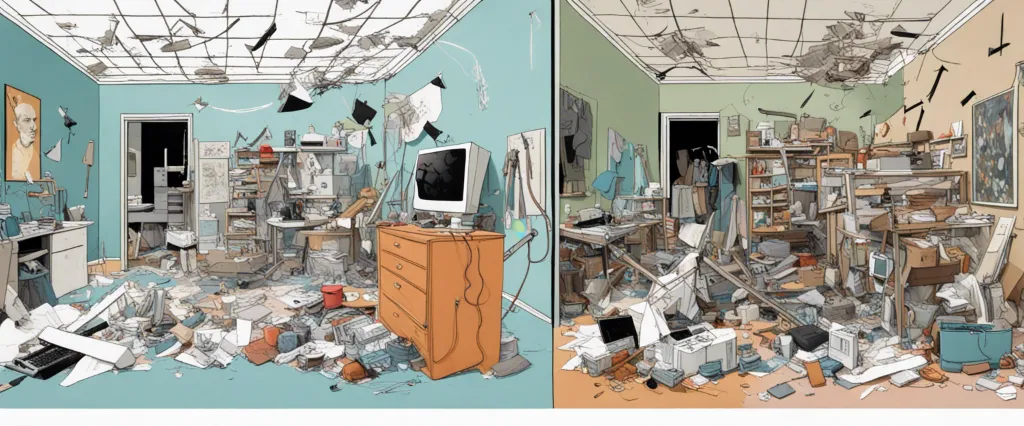In “Move Your Stuff, Change Your Life,” Karen Rauch Carter takes readers on a transformative journey to create harmony and success in their lives through the power of Feng Shui. This book offers practical tips and effective techniques to rearrange our living spaces and enhance the flow of positive energy, ultimately influencing every aspect of our lives. Karen Rauch Carter is an internationally renowned Feng Shui expert, best-selling author, and sought-after consultant. With decades of experience in this ancient art, she has helped countless individuals achieve tangible improvements in their well-being, relationships, and overall happiness by harnessing the energy of their surroundings. Through this book, Rauch Carter shares her vast knowledge with readers, empowering them to create a harmonious environment that supports their goals and transforms their lives.
Chapter 1: Environment and Energy Flow
Chapter 1: Environment and Energy Flow of the book “Move Your Stuff, Change Your Life” by Karen Rauch Carter focuses on the relationship between our physical surroundings and the flow of energy in our lives. Carter describes how the arrangement and organization of our living spaces can have a significant impact on our overall well-being and success.
The chapter begins by introducing the concept of Feng Shui, an ancient Chinese practice that aims to harmonize individuals with their environment. Carter explains that Feng Shui is not just about rearranging furniture or adding decorative items, but it is an art of creating balance and promoting positive energy flow.
Carter emphasizes the importance of recognizing that everything in our environment has its energy and affects us on a subconscious level. She explains that clutter, for example, can block the flow of energy and create stagnant areas in our lives. By decluttering and organizing our surroundings, we open up space for positive energy to flow freely.
The author outlines different areas of our living spaces, such as entrances, bedrooms, and kitchens, and provides practical tips to improve the energy flow in each area. She recommends paying attention to details like the placement of furniture, colors, and lighting. Furthermore, Carter stresses the significance of creating a supportive and nurturing environment that reflects our desires and goals.
In conclusion, Chapter 1 highlights the vital connection between our environment and our overall energy and well-being. By understanding the principles of Feng Shui and implementing simple changes in our living spaces, we can experience positive transformations in various aspects of our lives, including health, relationships, and success.
Chapter 2: Reorganizing Your Space
Chapter 2 of “Move Your Stuff, Change Your Life” by Karen Rauch Carter is focused on reorganizing your space in order to create a more harmonious and supportive environment. The chapter begins by emphasizing the importance of decluttering and getting rid of unnecessary items that do not serve any purpose. Carter explains that clutter can create stagnant energy and block the flow of positive chi in your space.
The author introduces the Bagua map, which is a Feng Shui tool used to divide your space into nine different areas, each corresponding to different aspects of your life such as career, health, relationships, and creativity. She explains how to apply the Bagua map to your home or specific rooms to determine which areas need attention.
Carter provides practical tips on how to reorganize each area according to the specific needs associated with it. For example, she suggests optimizing the career area by keeping a clean and clutter-free workspace, adding elements that symbolize success and abundance, and using imagery or objects that represent your career goals.
The chapter also emphasizes the importance of the front entrance and foyer, as it is considered the mouth of chi and sets the tone for the entire space. Carter provides guidance on how to create an inviting and welcoming entrance that encourages positive energy to flow into your home.
Lastly, the chapter touches on the influence of color and how using specific colors in certain areas can further enhance the energy flow and support specific areas of your life.
Overall, Chapter 2 of “Move Your Stuff, Change Your Life” highlights the importance of reorganizing and optimizing your space based on Feng Shui principles. By decluttering, applying the Bagua map, and incorporating specific elements and colors, you can create a harmonious and supportive environment that invites positive energy and helps manifest your goals and desires in various aspects of life.
Chapter 3: Clearing and Purifying
Chapter 3 of “Move Your Stuff, Change Your Life” by Karen Rauch Carter is titled “Clearing and Purifying” and focuses on the importance of decluttering and cleansing one’s living space to create positive energy and manifestation.
The chapter starts by highlighting how clutter and excess belongings can weigh us down and inhibit the flow of energy in our lives. Carter emphasizes the significance of decluttering as a necessary step towards creating a harmonious environment. She provides practical tips on how to clear out physical clutter, emphasizing the importance of being selective and letting go of items that no longer serve a purpose or bring joy.
In addition to physical clutter, Carter acknowledges the existence of energetic clutter in our homes. This refers to the energy or emotional residue left behind by previous occupants or negative experiences. To cleanse this energetic clutter, she suggests various techniques, such as smudging with sage or palo santo, using essential oils, and playing uplifting music. These methods help to purify the space and create a fresh energy that is conducive to positive change.
Carter also explores the concept of feng shui, a Chinese philosophy that focuses on the arrangement and flow of energy in a space. She discusses the importance of arranging furniture and objects in a way that promotes positive energy flow and supports our specific goals and intentions.
The chapter concludes by emphasizing the transformative effects of clearing and purifying our living spaces. By removing clutter and revitalizing the energy, we create a more receptive environment that supports our desires and goals. Carter highlights how this process is not just about physical changes but also about creating a mental and emotional shift towards positivity and abundance.
Chapter 4: Adjusting Furniture Placement

Chapter 4 of “Move Your Stuff, Change Your Life” by Karen Rauch Carter discusses the significance of adjusting furniture placement within a space to improve the flow of energy and create a harmonious environment. The author introduces the concept of the Bagua map, a feng shui tool used to analyze different areas of a home and their corresponding aspects of life.
Carter emphasizes the importance of creating supportive and functional energy flow within each room. She provides detailed instructions on how to lay the Bagua map over a floor plan, identifying specific areas associated with aspects such as wealth, health, relationships, and career. By aligning furniture and objects according to the Bagua map, one can positively influence these areas of life.
The author then guides readers through the eight life areas and suggests practical adjustments. She advises positioning the bed to face the entrance and not aligning it with the door to enhance relationships. Placing a desk against a wall and facing the door can improve focus and career prospects. Carter also recommends removing all clutter from each area to allow energy to circulate freely.
Furthermore, the author provides insights into the importance of balance and symmetry in furniture placement. She suggests creating balance by placing pairs of objects or elements in each room, such as matching nightstands on either side of a bed or symmetrical artwork on the walls.
Carter concludes the chapter by emphasizing that adjusting furniture placement can positively impact the energy flow of a space, resulting in noticeable improvements in various aspects of life. By following the guidelines provided and making intentional changes, readers can create a more harmonious and supportive environment.
Chapter 5: Decorating and Color Selection
Chapter 5 of the book “Move Your Stuff, Change Your Life” by Karen Rauch Carter provides insights and practical tips on decorating and color selection to transform your living space and improve your well-being. The author emphasizes that the arrangement and color of objects in your environment can profoundly affect your energy, mood, and overall quality of life.
Carter starts by explaining the concept of the Bagua, an essential tool in Feng Shui, which divides a space into nine areas representing different aspects of life. She guides the readers on how to align various objects and colors in each area to harmonize the energy flow, fostering balance and positive intentions in those areas.
The chapter delves into the significance of colors and how they can impact our emotions and energy levels. Carter provides a detailed breakdown of the psychological effects of various colors, suggesting which colors are suitable for different rooms based on their purpose and the desired atmosphere. For example, she recommends using soothing, earthy tones for bedrooms to promote restful sleep, energizing colors like red or orange for exercise spaces, and calming blues or greens for areas of relaxation.
In addition to color, the author also highlights the importance of decluttering and personalizing your living space. She advises readers to surround themselves with objects that they love and that reflect their identities and aspirations. By selecting meaningful decor, arranging furniture in a manner that encourages social interaction, and incorporating elements of nature, individuals can create a space that nurtures and supports their well-being.
Overall, Chapter 5 offers a comprehensive guide to decorating and color selection in accordance with the principles of Feng Shui. It empowers readers to create an environment that positively impacts their energy, emotions, and overall life experience.
Chapter 6: Wealth and Prosperity
Chapter 6 of “Move Your Stuff, Change Your Life” by Karen Rauch Carter focuses on the concept of wealth and prosperity and how it can be influenced by the arrangement and energy flow within our living spaces. Carter begins the chapter by explaining the importance of understanding our beliefs and attitudes towards money and wealth, as these beliefs directly impact our ability to attract abundance.
She emphasizes the significance of the wealth area within the Bagua, a feng shui energy map used to analyze different areas of our homes. Carter suggests that decluttering and organizing this area, particularly the entrance and workspace, can help clear any energetic blocks that may hinder financial growth.
Furthermore, the author introduces the concept of a “wealth-enhancing object,” an item that can act as a symbol of prosperity and abundance. Placing such an object in the wealth area can serve as a visual reminder of our intentions and desires for wealth.
Carter also discusses the influence of color and its impact on energy flow within the wealth area. She suggests incorporating shades of purple or green, as these hues are believed to promote prosperity.
Additionally, the chapter explores the importance of a clear and functional desk space, as clutter can inhibit productivity and financial success. Carter provides practical tips on organizing paperwork and creating an environment that fosters focus and efficiency.
Overall, Chapter 6 of “Move Your Stuff, Change Your Life” emphasizes the significance of intention, clutter-clearing, and energy enhancement in attracting wealth and prosperity. By understanding and applying these principles, readers can make fundamental changes to their living spaces that align with their financial goals and invite abundance into their lives.
Chapter 7: Relationships and Love
Chapter 7 of the book “Move Your Stuff, Change Your Life” by Karen Rauch Carter focuses on the principles of relationships and love. In this chapter, Carter explains how the physical arrangement and design of our living spaces can impact our relationships and the flow of love in our lives.
The author begins by emphasizing the importance of creating a balance between the masculine and feminine energies within our homes. She suggests that an imbalance in these energies can lead to disharmony in relationships. Carter provides practical tips for enhancing the feminine energy in the home, such as incorporating soft colors, curved lines, and comfortable furniture.
Carter also explores the concept of the relationship gua, which refers to the specific areas of a space that are connected to relationships and love. She explains that by enhancing this area, individuals can attract and strengthen their romantic relationships. The author provides various techniques for activating this gua, including using pairs of objects or artwork, displaying symbols of love, and increasing the amount of light in the area.
Furthermore, Carter highlights the importance of decluttering and organizing our spaces to improve our relationships. She explains that a cluttered environment can obstruct the energy flow and create tension or stagnation in relationships. By creating clean and organized spaces, individuals can facilitate the flow of positive energy and improve the quality of their relationships.
Overall, Chapter 7 of “Move Your Stuff, Change Your Life” emphasizes the vital role that our living spaces play in our relationships and love lives. By applying the principles and techniques shared by Carter, readers can make intentional changes to their environments to enhance their relationships and attract more love into their lives.

Chapter 8: Health and Happiness
Chapter 8: Health and Happiness of the book Move Your Stuff, Change Your Life by Karen Rauch Carter focuses on the connection between our physical environment and our mental and physical well-being. Carter explains how our surroundings have a direct impact on our health and happiness.
The chapter begins by highlighting the importance of the bedroom as it is where we spend most of our time rejuvenating and resting. Carter emphasizes the importance of positioning the bed in a commanding position, ensuring that it can be easily seen from the door without being directly in line with it. This promotes a sense of security and control, leading to better quality sleep and overall well-being.
Carter also touches upon the significance of proper lighting in our living spaces. She emphasizes the importance of natural light and advises maximizing its presence in our homes. Natural light has numerous benefits, such as improving mood and energy levels, boosting productivity, and regulating sleep patterns. Additionally, the book highlights the use of color and how it can influence our emotions and behavior. Stimulating colors like red and orange can increase energy levels, while cool colors like blue and green promote relaxation and calmness.
The chapter further delves into the importance of maintaining cleanliness and organization in our living spaces. A clutter-free and clean environment not only enhances the aesthetics of the space but also promotes a sense of calmness and clarity. Carter suggests decluttering as a way to release stagnant energy and create space for new opportunities and positive experiences.
Carter also addresses the significance of plants and nature within our living spaces. She explains how indoor plants not only improve air quality but also act as natural stress-relievers, reducing anxiety and enhancing overall well-being.
Overall, this chapter emphasizes the interdependence of our physical environment and our health and happiness. By applying the principles mentioned, individuals can create a harmonious living space that supports their well-being and promotes a healthier, happier life.
After Reading
In “Move Your Stuff, Change Your Life” by Karen Rauch Carter, the author explores the ancient practice of Feng Shui and its impact on our physical and emotional well-being. She emphasizes the importance of arranging our living spaces in harmony with the principles of energy flow and balance. By making intentional changes in our environments, we can create positive shifts in all aspects of our lives, such as relationships, career, and personal growth. Through practical tips and personal anecdotes, Carter guides readers in transforming their homes into spaces that support their goals and aspirations. This book serves as a valuable resource for anyone seeking to improve their overall happiness and success by harnessing the power of their surroundings.
1. “The Life-Changing Magic of Tidying Up” by Marie Kondo
– This book helps readers declutter and organize their homes using the KonMari method. Similar to “Move Your Stuff, Change Your Life,” it emphasizes the impact of organizing on one’s overall well-being.
2. The Power of Now: A Guide to Spiritual Enlightenment” by Eckhart Tolle
– Tolle’s book explores the concept of living in the present moment and letting go of negative thoughts and attachments. Like “Move Your Stuff, Change Your Life,” it encourages readers to create space in their minds and surroundings for positive change.
3. How to Stop Worrying and Start Living” by Dale Carnegie
– Carnegie’s book offers practical tips and strategies to free oneself from worry and live a happier life. It complements “Move Your Stuff, Change Your Life” by providing methods to eliminate mental clutter and generate more positive energy.
4. “The Life-Changing Habit of Tidying Up Your Mind” by Brooke Castillo
– This book draws on principles from cognitive science and coaching to guide readers through decluttering their minds. Like “Move Your Stuff, Change Your Life,” it focuses on the connection between mental and physical clutter and their impact on personal growth.
5. “The Happiness Project” by Gretchen Rubin
– Rubin’s book chronicles her year-long journey to find happiness and fulfillment. With its emphasis on taking small steps towards self-improvement, it aligns with the practical approach found in “Move Your Stuff, Change Your Life.” Both books offer tips to transform one’s life for the better.




